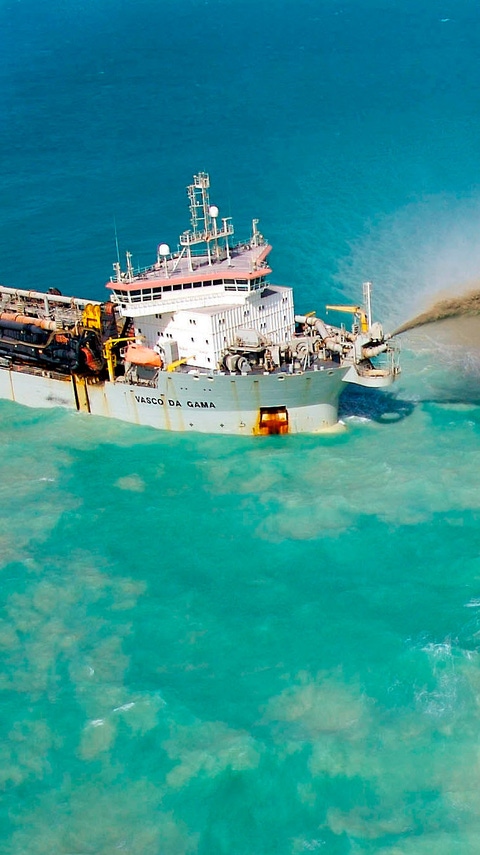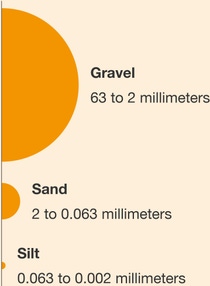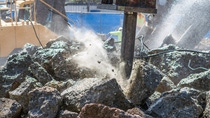30 billion
metric tons of sand are shoveled into cement mixers around the world every year

Topic
Sand is everywhere? Not any more
Priopćenja i novosti
30 billion
metric tons of sand are shoveled into cement mixers around the world every year
“It’s not so easy to find good-quality sand anymore,” says Professor Dietmar Stephan, Head of the Department of Building Materials and Construction Chemistry at TU Berlin, Germany. This is primarily due to the construction boom. “When it comes to concrete production, roughly 3 metric tons of sand are needed per metric ton of cement,” explains Stephan. In 2014, the UNEP estimated that between 26 and 30 billion metric tons of sand are poured into cement mixers every year worldwide.
Since then, these numbers will have only increased. The demand for this raw material in expanding metropolises such as Singapore, Shanghai, or Dubai is always growing. Mega construction projects in these cities are already devouring vast quantities of sand, as we see with the numerous major projects in Dubai. The raw material is not only needed to erect huge skyscrapers like the Burj Khalifa. The foundation for Dubai’s Palm Jumeirah artificial island in the Persian Gulf is also formed from a massive deposit of these fine grains. According to media reports, more than 150 million tons of sand were delivered from Australia.
Without sand our world would look very different because it is in almost everything we use. Three examples.
Meanwhile, the sand from the surrounding deserts remained untouched. “Desert sand simply cannot be used as a building material,” says Oliver Mazanec, head of Product Management at BASF Construction Solutions. The wind sweeps it up and blows it away. The grains become small, smooth, and uniform. The result: “The grains of sand do not mesh and cavities form in the fresh concrete. This significantly increases the amount of water needed when mixing cement, which adversely affects the strength of the concrete.”
Extremely rough edges are required for construction work. But this type of sand can only be found in quarries, riverbeds, and the ocean – with negative consequences for the environment. According to UNEP estimates, three out of four beaches could simply vanish in the future. This is due to the raw material being mined directly on beaches, which is often illegal, and because beaches are slipping as sand is being drawn off the seabed. Entire islands in Indonesia, for example, have already fallen victim to this phenomenon. The power of the waves also makes sure that sand drifts away. But there are also shortages inland. Easily accessible deposits of high-silicon quartz sand are slowly being depleted.
The amount of affordable sand is drastically decreasing.”
This shortage has made sand a scientific priority. We are now looking for ways to make better use of the resources. One of these methods has been in use since 2016: a process developed by BASF to convert sand that was previously unsuitable for high-quality concrete into a valuable raw material. This involves using clayey sand or sand with a high proportion of ultra-fine additives, such as mica. Clay and mica absorb large amounts of water due to their large surface area and their special, partially expandable structure – they also absorb the superplasticizer needed for concrete mixing. This has unwanted consequences: the concrete cannot be processed.
“The MasterSuna sand blocker from BASF improves the properties of these challenging sands. It ensures that water and superplasticizer are not absorbed by the sand, and instead the concrete is generously liquefied,” says Mazanec. Sands that were previously unsuitable can now be used, and existing deposits can be more intensively exploited. This new admixture is currently available in France, Spain, Germany, the United Kingdom and Australia. These countries are particularly affected by sand contaminated with clay.
Laboratories around the world are also looking into ways to exploit the abundance of fine desert sand. One idea, for example, is to enrich it with fly ash, so the cement adheres to the finely ground sand grains more effectively during concrete mixing. Another idea is to use plastics, such as polyester resins from crude oil, as a binder instead of cement. “This basically resolves the issue, but it isn’t feasible on a large scale. Or isn’t a permanent solution, as with the fly ash. This is because it involves coal combustion, which will be an increasingly rare method of power generation in the future,” says building materials expert Stephan.
A far more promising solution than desert sand is old concrete. If building rubble is pollutant-free, it can be recycled relatively effectively in a process involving separation, shredding, and fine grinding. This mineral rubble sand needs to contain at least 25 percent concrete to bear the label “recycled concrete.” To date, recycled concrete has primarily been used to form sublayers in road construction. Recycled concrete is still the exception when it comes to house construction. “It’s technically feasible, but its success will be determined by price,” Stephan says. The price is generally higher, although it fluctuates considerably from region to region. And because rubble sand does not have the same ideal grain size as fresh sand, it is more difficult to process.
Sand and gravel are among the most important resources in the world. Diameter is one of the key factors used to differentiate them.
Most sand is not produced from ground-up shells in the ocean. It is far more common for it to be formed from stones that have been weathered and eroded over thousands of years, and transported to the ocean via rivers. Sand primarily consists of quartz, a compound of silicon and oxygen. Quartz appears in such large quantities in sand because it occurs very frequently in the earth – specifically in the earth’s crust. Being very resistant, quartz also withstands erosion well. It is harder than steel.
An accumulation of rounded small stones in rivers or streams. Together with sand, gravel is one of the most important raw materials for the construction industry – for use in concrete, for example.
This soil, which is defined only by its grain size (between sand and clay), is very rarely found in its pure form in nature. In most cases, it appears mixed in with sand and/or clay – and in this form it is known to us as mud..
According to the building materials expert, rubble sand accounts for less than 1 percent of concrete in new buildings. “But the amount of affordable sand is decreasing so drastically that the outlay required for recycling will probably be less expensive than for the raw material at some point in the future. More research could also speed this up,” Stephan says. Switzerland and the Netherlands have already been rethinking the matter. These two countries are considered pioneers in recycled concrete. For example, new public buildings in Zurich are no longer being built without recycled building materials. Stephan is convinced that “recycled concrete is one of the building materials of the future.”





